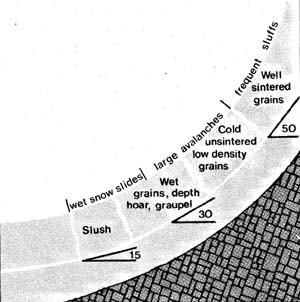Point release avalanches, or
loose snow slides, begin at
one point on a slope and get progressively wider as they proceed down the
slope. A fundamental characteristic that must be present for this
type of avalanche to occur is a surface layer of cohesionless, or nearly
cohesionless, snow (University of Colorado IBS 1975; Fredston and Fesler
1994). An initially small amount of snow begins to move downward when
the force of gravity is greater than the forces of cohesion at a particular
angle or when debris from above starts the snow in a downward direction and
there is not enough friction or resistance to sliding and rolling. Because
there is little to no cohesion and the surface layer, the initially small
amount of snow is able to dislodge other snow particles below it and increase
in cumulative size as it moves downhill. The avalanche increases in
horizontal width because snow particles are dislodged laterally, as well.
While a surface snow layer that never becomes cohesive is obviously
vulnerable to this process, these avalanches often occur when external forces,
such as sun and rain, weaken bonding in this layer until cohesion is little
enough that some snow breaks free (Graydon and Hanson 1997). The angle
of the snow slope ultimately determines at what point cohesionless snow will
be able to break free, and varies for the type of snow on that slope. This
critical angle at which the snow will begin to slide is called the angle
of repose (Daffern 1983). The following diagram shows general breakpoints
for this angle of repose. The technical descriptions of the snow types
is not important for this immediate discussion, and can be read about in
more detail in Daffern's publication (1983). The important point is
that extremely cohesionless snow, such as slush, will begin to slide even
on the most gradual of slopes, and greater angles are required for progressively
more cohesive forms of snow to break free, with well sintered grains being
the most cohesive.

Figure from Daffern 1983
While many point release slides remain small and relatively
harmless, others can be extremely dangerous if they are just forceful enough
to dislodge a human from a safe perch or cliff, or if the magnitude of
the slide is enough to include a human in the accumulation of snow which
can lead to a burial of the person when it stops. A couple basic laws
of physics will determine the magnitude of these slides. The vertical
height of the starting point will determine how much kinetic energy can be
gained when it is converted from potential energy, and the accumulation of
mass affects both the potential energy available and the momentum, which
is crucial at the point of contact with a human.
home page
slab avalanches